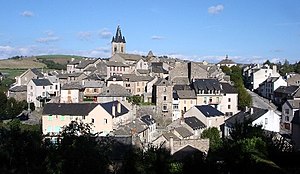Salles-Curan
|
Salles-Curan Las Salas |
||
|---|---|---|

|
|
|
| region | Occitania | |
| Department | Aveyron | |
| Arrondissement | Millau | |
| Canton | Raspes et Lévezou | |
| Community association | Lévézou Pareloup | |
| Coordinates | 44 ° 11 ' N , 2 ° 47' E | |
| height | 547-1,084 m | |
| surface | 93.90 km 2 | |
| Residents | 1,043 (January 1, 2017) | |
| Population density | 11 inhabitants / km 2 | |
| Post Code | 12410 | |
| INSEE code | 12253 | |
| Website | Salles-Curan | |
 Salles-Curan - town view |
||
Salles-Curan ( Occitan : Las Salas ) is a place and a municipality in the south of France with 1,043 inhabitants (as of January 1, 2017) in the Aveyron department in the Occitania region . The municipality consists of the main town and four hamlets Bouloc , Canabières , Saint-Martin-de-Faux and Larguiès .
location
The place Salles-Curan is located on an approx. 855 m high hill on the plateau of Lévézou , part of the historical province of Rouergue and the Massif Central . The city of Millau is approx. 36 km (driving distance) in a south-easterly direction; the city of Rodez is about 38 km northwest. The Lac de Pareloup reservoir is only 3 km away.
Population development
| year | 1800 | 1851 | 1901 | 1954 | 1999 | 2013 |
| Residents | 1,164 | 2,768 | 2,503 | 1,692 | 1,088 | 1,064 |
The population decline in the 20th century is largely due to the loss of jobs as a result of the mechanization of agriculture .
economy
For a long time, the place Salles-Curan served the exclusively agriculturally oriented hamlets ( hameaux ) and individual farmsteads in the area as a craft, trade and service center. Since the middle of the 20th century, tourism in the form of renting holiday apartments ( gîtes ) has also played a not insignificant role in the local economy. A wind farm ( parc éolien ) was installed in the area in 2008 .
history
Salles-Curan was already important in Carolingian times. In the Middle Ages it belonged to the Counts and from 1237 to the Bishops of Rodez , who used the place as a summer residence at times . Towards the end of the Hundred Years War (1337–1453) the castle was renewed and the place itself was surrounded by a city wall ( remparts ); the church was also rebuilt and parts of it were used as a collegiate church.
Attractions
- The Château de Salles-Curan was built between 1441 and 1447 by the Bishops of Rodez. A prominent component of the closed courtyard is the stair tower built on a circular floor plan . It is privately owned and parts of it are rented out to guests. The building was recognized as a Monument historique in 1928 .
- A building in the middle of the village, also known as the “granary of the bishops” ( Grenier des Évêques ) and also from the 15th century, shows several cross- frame windows , one of which is in a corner. The building was also classified as a Monument historique in 1928 .
- The former collegiate church and today's parish church of Saint-Géraud is a late Gothic building from the 15th century. The nave is accompanied by side chapels with star vaults ; In the choir area with its original glass windows ( vitraux ) there is still the richly carved late Gothic choir stalls ( stalles ). The church has been recognized as a monument historique since 1927 .
- Larguiès
- About one kilometer northeast of Salles-Curan ( 44 ° 11 ′ 37 ″ N , 2 ° 48 ′ 2 ″ E ) is the building complex of the Château de Larguiès, which is closed on three sides . The partially three-storey building dates from around 1700; the interior was completely redesigned at the end of the 19th century. The main residential wing ( corps de logis ) has side stair towers that are reminiscent of medieval construction methods. The building complex has been recognized as a monument historique since 1981 .
- Bouloc
- At the end of the 12th century, the Order of St. John , who had extensive land in the area, founded a small (pilgrim) hospice here , of which the nave of the chapel still exists. The choir of the small church was renovated in the 15th century in Gothic style .
- Canabieres
- Around the year 1120, the Johanniter founded a (pilgrim) hospital here as well. The church of the formerly independent village was redesigned in the 15th century. In the entrance area of the church there is a holy water font, which was carved out of a capital; the remains of a stone cemetery cross worked on both sides are now placed in the church choir.
Web links
- Salles-Curan, history and places of interest - photos + info (French)
- Salles-Curan, church - aerial picture, photo + brief information (French)
- Salles-Curan, Château de Larguiès - Photos + information (French)
Individual evidence
- ↑ Château, Salles-Curan in the Base Mérimée of the French Ministry of Culture (French)
- ^ Maison, Salles-Curan in the Base Mérimée of the French Ministry of Culture (French)
- ↑ Église, Salles-Curan in the Base Mérimée of the French Ministry of Culture (French)
- ↑ Château de Larguiès, Salles-Curan in the Base Mérimée of the French Ministry of Culture (French)



